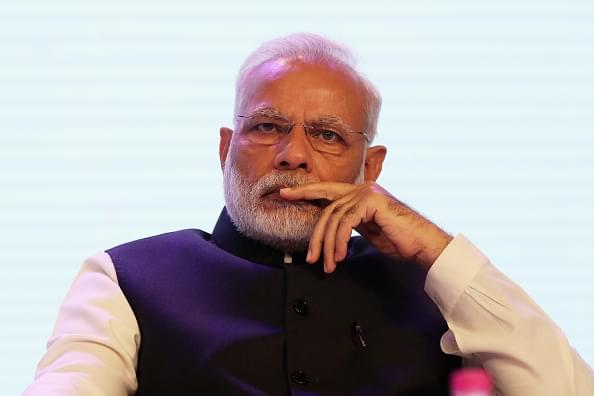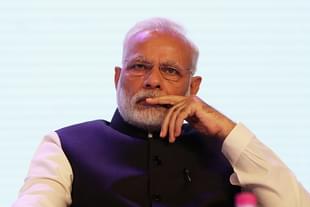Politics
In GST Implementation, A Real Test For Prime Minister Narendra Modi
Aashish Chandorkar
May 19, 2017, 10:39 AM | Updated 10:38 AM IST
Save & read from anywhere!
Bookmark stories for easy access on any device or the Swarajya app.


When Prime Minister Narendra Modi announced demonetisation on 8 November 2016, the opposition went all guns blazing in criticising the move. Twitter comparisons were made between the adverse effects of demonetisation and huge historical tragedies like the Syrian immigrant crisis and the Great Depression of 1929. While experts continue to debate the economic impact of demonetisation, it is undeniable that the political tailwind which the Prime Minister and the Bharatiya Janata Party (BJP) derived from the exercise was severely underestimated by the opposition as well as the attention-seekers on Twitter.
Perhaps that experience is holding the opposition back from questioning the government on the impending disruption from the implementation of Goods and Services Tax (GST). This disruption is likely to be far harsher than the one caused by demonetisation. The GST, of course, is the single-most important economic reform since the 1991 measures. Modi government deserves praise for finally getting this key legislation in place with a potential implementation date of 1 July 2017. But any change which overhauls an economic system is bound to be disruptive.
The after-effects of demonetisation were digested, even welcomed, from a sense of participation in an overwhelmingly virtuous act of cleaning up the Indian economy. No first- or second-quarter benefit will however be seen with implementation of GST to those who will be impacted by the new law. What matters, therefore, is how the government undertakes various change management measures in the wake of GST implementation. What matters is how long it will be before the GST rules, procedures and, most importantly, the backbone information technology (IT) systems stabilise.
Between 1 July and such stabilisation, the following issues will disrupt everyday life, not just for businesses but also for the end consumers, and therefore the wider economy.
First, technology readiness will pose a challenge. The Goods and Services Tax Network (GSTN) will be used by almost one crore entities, including those currently paying service tax, value-added tax (VAT) and central excise. These entities will have multiple users and agents (example, chartered accountants) operating on their behalf, so the network will have a very high user base on the first day. It is estimated that about 300 crore invoices will be uploaded on GSTN every month. This transaction volume is equivalent of running an Amazon-scale secure e-commerce site that is available 24x7! Compound the volume challenge with the fact that several businesses will have limited internet connectivity, poor IT systems, automation and lack of computer knowledge, and we have a veritable mix of problems on the cards.
Second, the GST provides for tax collection at all points in a supply chain after allowing a credit for the inputs. Determining the quantum of input tax credit is perhaps the most important activity in the GST regime for any business to compute tax liability. However, the credit claim needs a set of conditions to be met – the business should have a bonafide tax document like a tax invoice, and the suppliers should have paid appropriate GST. If a supplier defaults, the downstream business will not be eligible for input tax credit. GST structure provides for a “rating of suppliers” like one sees on e-commerce websites. But how and when this rating will be implemented is not clear.
Third, since there is a cascading impact of tax compliance in a supply chain, there are potential points of conflict. If an intermediate entity does not pay its share of GST and a downstream business is denied input tax credit, this will lead to severe working capital crunch for the downstream business. Given that the downstream business size tapers in Indian retail and consumer context, while the intermediate businesses (wholesalers, dealers, and stockists) are most prone to tax evasion practices, it can lead to severe last-mile working capital problems. These last-mile businesses almost always find it difficult to attract credit. So, in the short term, they run the risk of being held hostage by their suppliers or they may trade volume expansion and business activity with GST compliance needs.
Fourth, several industries will witness severe de-stocking in the run up to the GST go-live. These industries will include pharmaceuticals, consumer goods and consumer durables, among others. There are two main reasons for this. Retailers and wholesalers will not want to sell goods held in inventory for which they have already paid VAT, as there is no clarity on the tax credit rules for this first cut-over to the GST regime. Secondly, since the GST slabs for various goods aren’t yet published, it compounds the mismatch between VAT paid against potential new GST slabs. So there may be supply shortages in consumables in the first quarter of GST going live. Given that the monsoon months see supply shortages anyway due to slower goods movement, there may be a compounding effect on supplies, leading to price rise.
Fifth, GST readiness varies drastically from industry to industry. While large manufacturing, retail, distribution and consumer goods firms have been prepared for the oncoming changes, the service businesses have been laggards. Several banks and financial institutions have floated requests for proposals in April and May to get their processes and systems GST-compliant. Given the lack of bandwidth of the tax consultants and technology firms close to July, it is quite likely that several large financial service businesses will enter the GST regime with a half-baked understanding of the rules, leading to customer complaints.
Sixth, all businesses registered under GST will have to file returns. There are 11 GST returns forms, applicable differently to different businesses and at various periodicity (monthly, quarterly and annually). The returns filing process also allows for buyers and suppliers confirming the details of a sale online. Given that several businesses in India don’t even file taxes, let alone keep methodical records of supplier purchases and onward sales, there are bound to be teething troubles.
Seventh, there are changes to the indirect taxation rules themselves. An example: GST becomes applicable if a dealer collects advance payment against future supply and the tax has to be paid in the month of payment collection. Now, if the dealer sells goods which fall in multiple tax brackets, and there is no way of knowing the future order, the dealer can’t apply the right tax rate on such advances. To complicate further, if no supply is made in this situation and ultimately that advance is returned or part-returned, there is no clarity on how the dealer will claim input credit. Essentially, a lot of practical, day-to-day exceptions will occur, and GST rules may fall short of addressing these exceptions.
Eight, there have been some unnecessary complications in GST implementation. One such area is the use of e-way bills for transporting goods. Goods transportation requires the supplier to upload details of the shipment on the GST portal and obtain an e-way bill number, which then needs to be tagged along with the invoice for supply. There are other complications on e-way use in case of cancelled orders, vehicle inspections in transit and debit note issuance for returns. Further, the e-way bills will have different validity of use in number of days depending on the distance the goods need to travel. These rules are open to inspector misuse and discretion, and could have well been avoided in the core design. Given the design, there may be a lot of confusion in goods movement in the early days of GST, further exacerbating shortages.
Ninth, given the design, which is incumbent on invoice matching across the chain in which goods flow, several businesses will have to redesign their operating procedures. For example, in the GST regime, all credit and debit notes have to be identified against an invoice. In industries where returns are a regular feature, the current process is for the buyer to return all items, which could have been purchased under different invoices together. Going forward, the seller will have to issue multiple credit notes in such a scenario, identifying each return to its original invoice. This is an operating complication, and may hit small businesses with a low employee base and low margins hard.
Tenth, several businesses and their tax advisers are grappling with addressing issues like GST on free and sample goods with ill-defined understanding of the point of consumption. Service providers are trying to understand and fix tax credit issues arising out of using loyalty vouchers across states, given that interstate GST design will kick in.
The GST is an absolute must and will, in the next year or two, lead to the removal of several distortions from the economy. But before the tangible economic gain, ambiguity and adjustments will rule the roost.
The government has done well in communicating an overarching vision and creating a sense of urgency for the businesses. The GSTN is preparing to undertake mock runs in May and June. The government is already highlighting the virtues of compliance and the perils of tax evasion and backing words with action on defaulters.
While all this will perhaps ensure that the large- and mid-sized firms hit the ground running, the exception management processes will have to be very efficient and transparent. The tax inspector raj is the most dreaded bureaucratic relic in India. How the tax inspectors conduct themselves in the first year of GST implementation will perhaps guide incremental enrolment of small businesses in the taxation chain.
It perhaps demonstrates the intellectual bankruptcy of India’s political opposition that no one has asked the government tough questions on implementation challenges and the readiness to act in an agile fashion to resolve issues as they arise.
Prime Minister Modi carried the weight of demonetisation fallout deftly based on his personal credibility and brand. GST roll-out will require an encore performance.
(The author thanks Vivek Khaitan (@vk80 on Twitter) for his inputs to this article.)
Aashish Chandorkar is Counsellor at the Permanent Mission of India to the World Trade Organization in Geneva. He took up this role in September 2021. He writes on public policy in his personal capacity.





